Management and team appraisals based on 360-degree feedback
easyfeedback provides you with a simple and convenient tool for assessing managers, team appraisals or 1:1 feedback. Strengthen the professional and personal skills of your managers and employees.
AI Assistant ![]() for analyzing and interpreting the results.
for analyzing and interpreting the results.




The 360 Degree Feedback Management
The assessment of leadership and management qualities is of great importance for executives and the company. Through a 360 degree feedback, the professional and personal competencies of executives can be determined at the current state and successively improved.
Through the reporting, the manager receives a comparison of his own assessment and the external assessment and can recognize where differences arise and thus actively work on them.
For the company, this results in an overall picture of all managers as well as each individual manager, so that the strengths and weaknesses of managers can be identified in a targeted manner. As a result, managers can be better deployed in other areas or their weaknesses can be strengthened in order to better represent the company’s goals.
With easyfeedback, you receive a feedback tool with which you can map your individual structure for 360, 270 or 180 degree feedback. The free 360 degree templates help you to set up the survey in a short time and adapt it to your situation.
And thanks to the automatic 360 degree report, you will immediately see a result from the first participation and can discuss it with the manager after completing the 360 degree feedback.
Implementation of 360 degree feedback
Why easyfeedback?



Ready to get started right away
easyfeedback is ready to use immediately. After your registration you simply download the 360 degree feedback template, adapt it to your needs and invite the participants.
Cost-effective 360 degree tool
Whether you want to conduct 360-degree feedback for 1 or 1,000 executives, the price is fixed. With our business plan, you already get all the features you need at a fixed price.
AI analyses & interpretations
With the integrated AI analyses, you receive a complete interpretation of the results within minutes and can show each manager where the differences between the individual perspectives lie and which measures will help the manager to improve.
Simple and intuitive design
Thanks to 14 different question types, you can design your 360 degree feedback the way you want: one question per page or several questions combined into one topic. The integrated 360 degree features help you build the assessment perspectives.


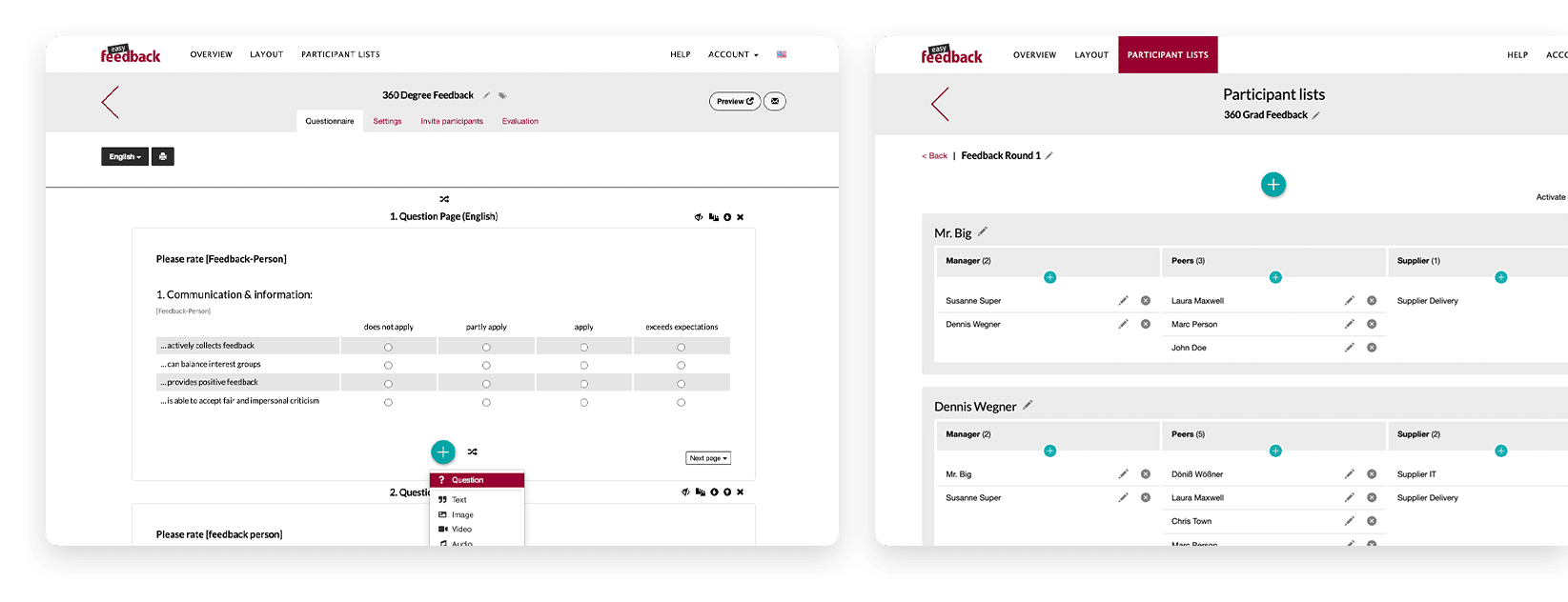
Filters & logics
Questionnaire variants
90, 180, 270 or 360 degree
Get assessments from any device
Desktop, tablet or smartphone – your 360 degree feedback automatically adapts to each end device. This allows each participant to decide from which device they would like to provide their feedback.
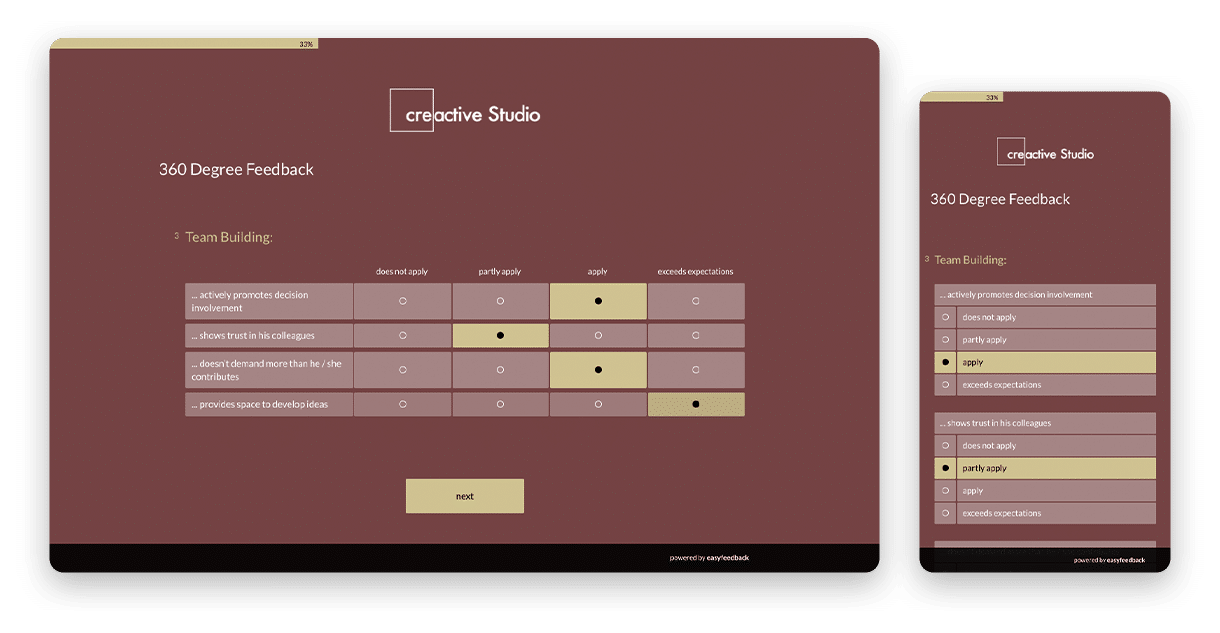

360 degree report in real time
With the comparative results display, you receive an individual 360 degree feedback report per manager and can share it with the people involved or the manager in real time.
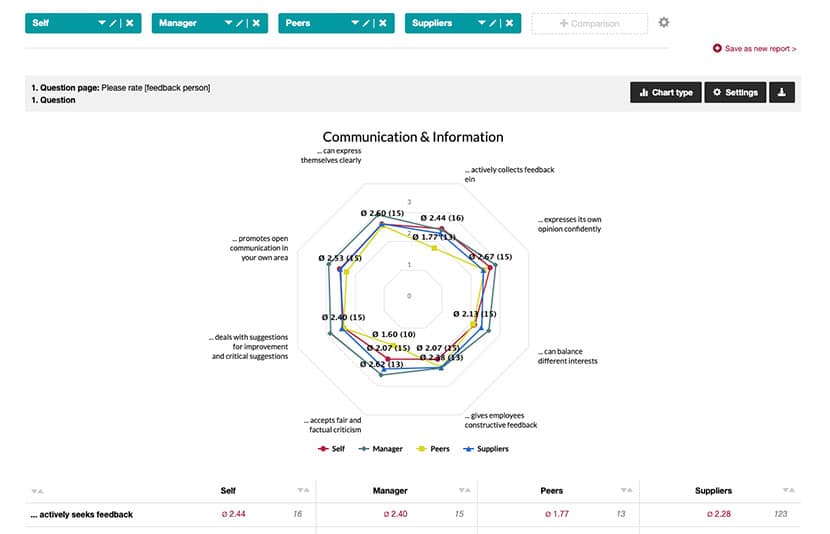
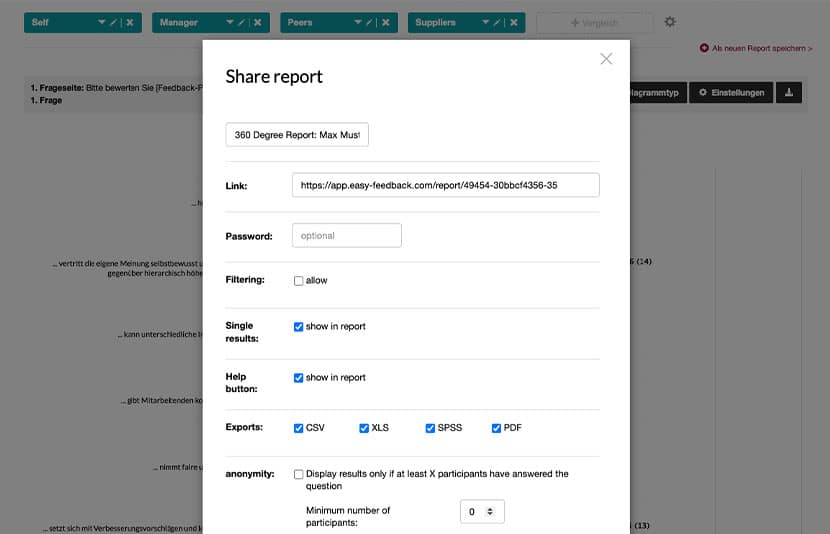
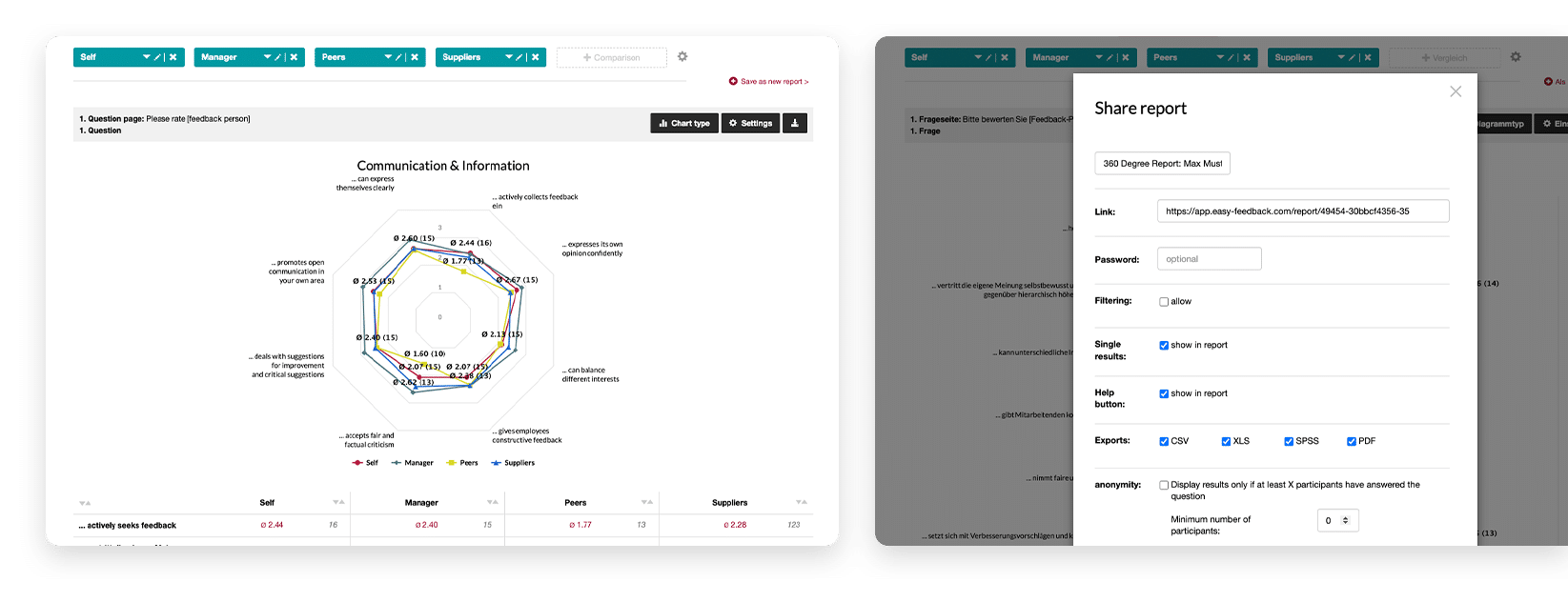
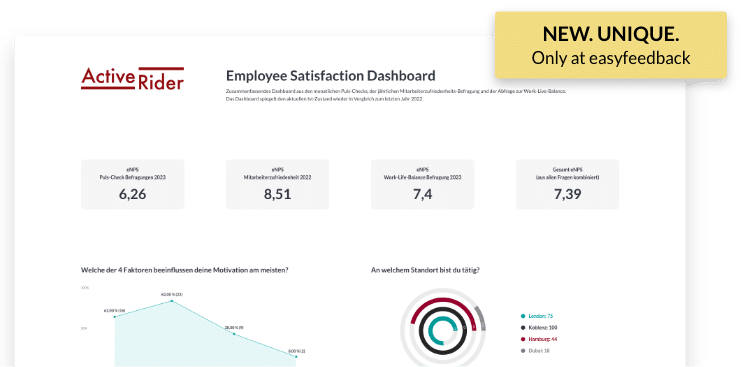
Almost everything you need to know about 360-degree feedback
What is 360 degree feedback? Meaning and objective
A 360 degree feedback (also called 360 degree feedback, 360 degree appraisal or 360 degree assessment) is a very important and efficient method of personnel development, in which specialists and managers are assessed with regard to their competencies and performance from different perspectives (direct superiors, colleagues, customers, etc.).
But not only the external perception is included in the 360 degree assessment. The self-assessment of the assessed person is also an important aspect of this survey instrument.
The 360 degree survey is designed to uncover strengths, weaknesses and development potential of the assessed specialist and manager by comparing the external and self-assessment.
The resulting 360° profile enables the employer to initiate career advancement measures, such as the further development of previous ones or the acquisition of missing skills and performance.
A 360 degree appraisal survey can also be used to check the suitability of a future promotional position or to compare performance and competence with other managers and department heads.
What is the purpose of a 360 degree survey?
A 360 degree survey is useful when it comes to the professional development of managers. By comparing self-perception and external perception, a comprehensive and realistic profile of the professional skills and performance of the specialist and manager being assessed can be created.
This 360° profile serves as a basis for the discovery of hidden performance potential, changes in personality traits and the acquisition of missing professional competencies.
Which factors play an important role in the success of a 360 degree feedback?
Several factors play an important role for the success of a 360° feedback.
One of the success factors of the 360° survey is validity. During the creation phase, it should always be questioned whether, on the one hand, the quality of the questionnaire is in line with the desired objective. Do the questions and media used help to achieve the objective of the 360-degree survey?
This is extremely important, as otherwise the acceptance and effectiveness of the 360° survey will suffer. If the questionnaire does not meet the requirements, then no verifiable results can be put into practice and the acceptance of the survey instrument decreases among the participants.
A further success factor of the 360 degree appraisal is anonymity. It is important that the assessment of the executive by other persons (external perception) must always be anonymous. Only then will the executive to be assessed and the company receive constructive and honest opinions and answers about his or her person and competencies.
Furthermore, the results and answers resulting from the 360-degree survey should be discussed promptly with the manager in an intensive feedback discussion.
From the discussion itself, potential for change and development can be discovered, goals agreed upon and a subsequent development plan drawn up. When agreeing on goals, you should not only set up personal but also success-oriented key figures. On the one hand, these corporate key figures make an important contribution to the company’s success and on the other hand, if the target is achieved, it can represent a personal sense of achievement for the manager.
The subsequent coaching and behavioral observation form a further success criterion for the 360 degree evaluation. If a competency is to be successfully acquired or developed, this must be ensured by a mentor who is capable of teaching. This is the only way for companies and executives to benefit from the 360 degree feedback development tool.
Which persons are involved in a 360 degree assessment?
Since a 360-degree feedback is an assessment from several perspectives, several groups of people are involved in the feedback instrument.
On the one hand the person carrying out or responsible for the 360° survey. This person is responsible for the proper execution of the subsequent evaluation and the final feedback discussion. He or she must have the appropriate qualifications and authority to play an active and competent role in all phases of the 360° survey.
On the other hand, the assessed specialist and manager, who takes on the role of self-perception. This person must be open, honest and capable of criticism and have the will to develop both personally and professionally.
Furthermore, superiors, colleagues, customers and other persons are involved in the 360-degree assessment. They should openly and honestly evaluate the personal as well as professional competencies of the specialist and manager and thus point out the external perception.
What are the benefits of 360 degree feedback?
With a 360 degree assessment, you give managers the opportunity to undergo a detailed professional evaluation from various perspectives. The comparison of self-perception and the perception of others allows the strengths, weaknesses, potential and talents of the executive to be identified. This identification opens up the opportunity for the assessed employee to develop professionally and character-wise.
A further advantage of the 360 degree survey is the significantly higher acceptance and the more objective view of the overall assessment by the manager. Because several people give their feedback on the person, the subsequent 360 degree profile is much clearer, as it does not depend on a subjective evaluation.
What are the variations of the 360 degree survey?
Depending on the number of perspectives, the 360 degree feedback can quickly become a 90°, 180° or 270° feedback.
Whereas in a 360 degree assessment, the opinions of both internal (employees, supervisors, etc.) and external persons (customers, partners, etc.) are used to evaluate the manager’s competencies and performance, with fewer perspectives the external persons are completely excluded from the survey.
Without external perspectives, the 360 degree feedback becomes a 270 degree feedback. This therefore consists of the assessment from the manager’s own point of view, from the point of view of his or her supervisor, his or her own employees and colleagues who are on the same hierarchical level.
If we take out the appraisal perspective of the colleagues, we have transformed the 270 degree feedback into a 180 degree feedback, which consists of the own appraisal of the manager, the supervisor and the own employees.
A 90 degree feedback is created when the opinion of superiors is dispensed with and it is ultimately only a matter of self-assessment and assessment by one’s own employees.
How can I conduct a 360 degree feedback?
With a 360-degree feedback tool provider like easyfeedback, you can easily create, design and implement a standardized 360-degree questionnaire.
Build up your participant list, personalize your e-mail invitations and evaluate the results with your own filters. Compare the anonymously collected data and create a 360-degree profile from the comparison of self-perception and external perception.
Register for our survey tool for free. Create your own 360-degree questionnaire or use our ready-made template and start the all-round assessment of your specialist and manager.
What is the process of a 360-degree survey?
As with any survey, preparation, conception and a structured process are essential for the success of your 360 degree feedback.
To make it easier for you to implement your 360 degree assessment, we have put together a six-point flow chart below:
1. Goal definition
The first step in our flowchart is to define a clear goal for your 360 degree survey. What do you want to achieve with the survey? Is it to develop the executive in the area of leadership behavior or is it to make good personnel decisions?
No matter which goal you end up pursuing, it is important to make it clear that the goal is not to pillory the executive, but to provide constructive feedback that will serve the personal development of the person being evaluated. It is also important to communicate this goal to everyone involved. In this way, you create clear conditions and reduce uncertainties.
2. Planning
The next step is to plan the survey. When should the survey be conducted? What is the appropriate time? How long do the participants have to complete the survey?
Furthermore, the planning phase is about the design of the survey and the creation of the questionnaire. The questions used in it should in any case be meaningful and company-specific.
3. Implementation
Now it starts. The survey is carried out. Keep an eye on the participation rate to be able to intervene quickly in case of problems.
4. Evaluation
The next step is to evaluate the questionnaires. To do this, compile the anonymously collected data and create a 360 degree profile from the comparison of self-perception and external perception. In particular, this involves identifying the strengths and weaknesses of the manager.
Statistics on participation behavior can also be relevant for the evaluation. Here, questions such as: How many visitors and participants did the survey have in total, how many completed it, and how many dropped out?, are helpful.
5. Implement feedback
The results have been evaluated? Great, now it’s time for implementation. For this purpose, it is a good idea to hold discussions with the manager to discuss the results with the employee who has been evaluated. In this way, joint strategies can be developed to promote potential and compensate for weaknesses.
It also makes sense to define goals and steps for achieving them. These may include further training and continuing education, for example, or practical implementation in the workplace. Developments and progress should be recorded in regular small feedback meetings.
6. Repetition
After the survey is before the survey. To measure the effectiveness of the changes made, it makes sense to repeat the 360 degree appraisal after a period of about 6 months.
That was the 360 degree feedback process in a nutshell. For more information on 360-degree leadership assessment and the flowchart, feel free to read our blog article.
What questions can I ask in a 360° feedback?
For a comprehensive assessment of the manager, it is important to cover the following areas with the questions from the 360 degree assessment: communication & information, motivation, team development, planning & organization, leadership personality, results orientation, global mindset and overall performance. Below we have compiled a few possible questions for each topic area:
- Does Leader X take time to talk with his/her employees?
- Does Leader X pursue his/her goals in a sustainable manner?
- Does Executive X look for and take advantage of opportunities to try new things?
- Does Leader X prepare appointments and meetings well?
- Does Leader X involve employees in decision-making?
- Does Leader X encourage the development of his/her employees?
- Does Manager X accept fair and objective criticism?
For more inspiration on other possible questions, feel free to take a look at our ready-made survey template.
Are there any tips for conducting a 360-degree assessment?
Yes, there are. To make your 360 degree assessment a complete success, we’ve put together a few tips below:
Ensure the anonymity of the participants
To get honest feedback, it makes sense to collect the 360 degree assessment anonymously. Subordinate employees in particular avoid giving negative feedback to their supervisor for fear of consequences. For this reason, it is equally important that comments do not allow any conclusions to be drawn about the feedback provider, for example through spelling mistakes or the form of expression.
Test the survey before publication
The questionnaire is ready, so can you start with the survey? Before you send it out, you should do a pre-test. It’s best to ask an independent person to run through the survey once for you. This way, if any questions or problems arise, they can be easily resolved before the launch.
Inspiration for other areas
There’s no question that 360 degree feedback is great for evaluating managers. But it can also be used for other areas: For example, for evaluating employees, when selecting candidates for further training or when filling specific positions.
Those were our three tips for conducting a 360 degree leadership assessment. Now you’re ready to get started. Just give it a try.
Expert knowledge on 360 degree feedback
To help you use your 360 degree feedback as effectively as possible, we’ve prepared expert knowledge on how to create and execute it.
More than a survey tool

Excellent support
You’re a 360 degree professional or creating 360 degree feedback for the first time. If you need help, our excellent support is here to help.

Certified IT security
To protect your data, easyfeedback has been certified and only works with certified service providers.

Thousands of integrations
Use the connection to thousands of apps to connect your data more efficiently with other tools in a workflow.






